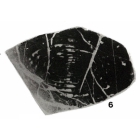
| Intro | | About | | Wiki | | Search traits | | Data explorer | | Literature | | Definitions | | Sources | | Webservices | | Statistics | | Feedback | | Editors | | Log in |
Foraminifera taxon detailsNagatoella Thompson, 1936 †
721839 (urn:lsid:marinespecies.org:taxname:721839)
accepted
Genus
Fusulina (Schellwienia) ellipsoidalis var. orientis Ozawa, 1925 † accepted as Nagatoella orientis (Ozawa, 1925) † (type by original designation)
marine,
fossil only
feminine
Thompson, M. (1936). Nagatoella, A New Genus of Permian Fusulinids. <em>The Journal of the Geological Society of Japan.</em> 43(510): 195-203., available online at https://doi.org/10.5575/geosoc.43.195
page(s): p. 196 [details] Available for editors
Diagnosis Test large, up to 7 mm in length, ellipsoidal, poles broadly rounded, adult tests with about thirteen whorls, septa...
Diagnosis Test large, up to 7 mm in length, ellipsoidal, poles broadly rounded, adult tests with about thirteen whorls, septa increasing from about eight per whorl in the early stage to thirty in the outer whorl, septa nearly plane in their upper part, widely spaced fluting at the base of the septa throughout the length of the test, locally forming cuniculi; wall of early whorls thin, later thicker, of tectum and thick, coarsely alveolar keriotheca that extends along the septa to result in a wedgelike form, tunnel wide and well developed, bordered by low, narrow, and asymmetrical chomata in the inner four to five whorls, later discontinuous, outer whorls with prominent secondary deposits on both faces of the septa as well as the inner surface of the chambers from the tunnel to the poles, axial fillings present in the early whorls. M. Permian (Kungurian); Japan; USA: California, Oregon. (Loeblich & Tappan, 1987, Foraminiferal Genera and Their Classification) [details]
Hayward, B.W.; Le Coze, F.; Vachard, D.; Gross, O. (2024). World Foraminifera Database. Nagatoella Thompson, 1936 †. Accessed at: https://www.marinespecies.org/Foraminifera/aphia.php?p=taxdetails&id=721839 on 2024-10-08
Date action by
original description
Thompson, M. (1936). Nagatoella, A New Genus of Permian Fusulinids. <em>The Journal of the Geological Society of Japan.</em> 43(510): 195-203., available online at https://doi.org/10.5575/geosoc.43.195
page(s): p. 196 [details] Available for editors basis of record Loeblich, A. R.; Tappan, H. (1987). Foraminiferal Genera and their Classification. Van Nostrand Reinhold Company, New York. 970pp., available online at https://books.google.pt/books?id=n_BqCQAAQBAJ [details] Available for editors From editor or global species database
Diagnosis Test large, up to 7 mm in length, ellipsoidal, poles broadly rounded, adult tests with about thirteen whorls, septa increasing from about eight per whorl in the early stage to thirty in the outer whorl, septa nearly plane in their upper part, widely spaced fluting at the base of the septa throughout the length of the test, locally forming cuniculi; wall of early whorls thin, later thicker, of tectum and thick, coarsely alveolar keriotheca that extends along the septa to result in a wedgelike form, tunnel wide and well developed, bordered by low, narrow, and asymmetrical chomata in the inner four to five whorls, later discontinuous, outer whorls with prominent secondary deposits on both faces of the septa as well as the inner surface of the chambers from the tunnel to the poles, axial fillings present in the early whorls. M. Permian (Kungurian); Japan; USA: California, Oregon. (Loeblich & Tappan, 1987, Foraminiferal Genera and Their Classification) [details]
|

